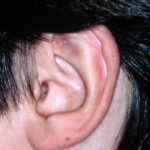
In the April 2018 issue of the journal Plastic and Reconstructive Surgery an article was published entitled ‘Comparison of Cartilage-Scoring and Cartilage-Sparing Otoplasty: A Retrospective Analysis of Complications and Aesthetic Outcome in 1060 Ears’. In this paper the authors report their experience with different otoplasty techniques over an eleven year period in a large number of ear patients. They used two different methods to set the ear back including cartilage-sparing and cartilage-cutting techniques. The authors compared these different technique by complications, rate of revision and aesthetic outcomes.
The occurrence of complications that did not require re-operation was similar in both groups at around 20%. Similarly the rate of re-operation for recurrent or asymmetry was 6% to 7% for both cartilage techniques. However in aesthetic outcomes the cartilage-sparing group consistently had superior postoperative shape scores than the cartilage-cutting group.
The aesthetic problem with cartilage-cutting techniques in otoplasty to bend the ear back is that they have the potential to leave sharp cartilage edges. Close inspection of the ear shows that it has no naturally sharper edges from the concha outward, they are all rounder being either concave or convex in form. As a result, it is not surprise that not cutting the cartilage creates a more natural setback otoplasty shape.
Dr. Barry Eppley
Indianapolis, Indiana



